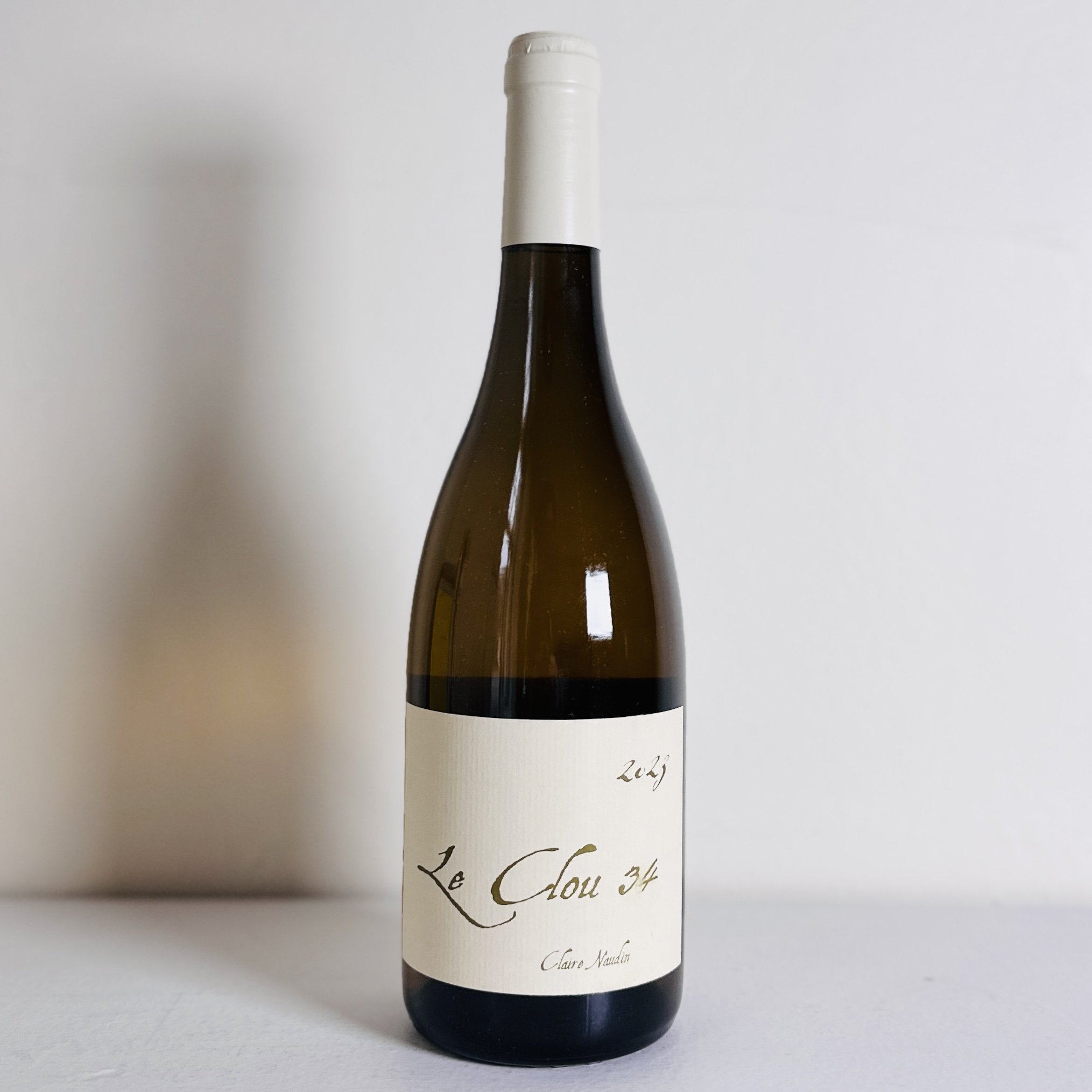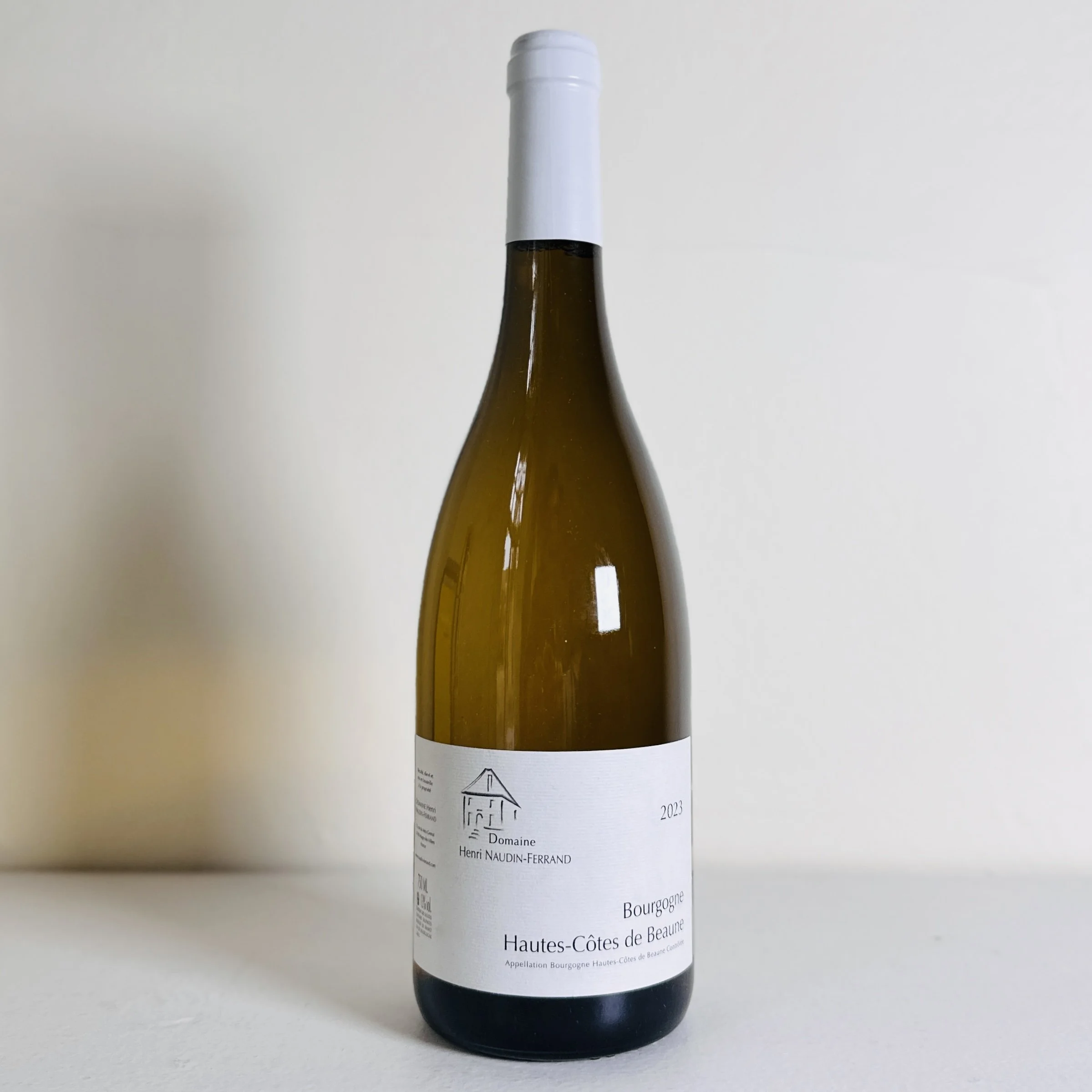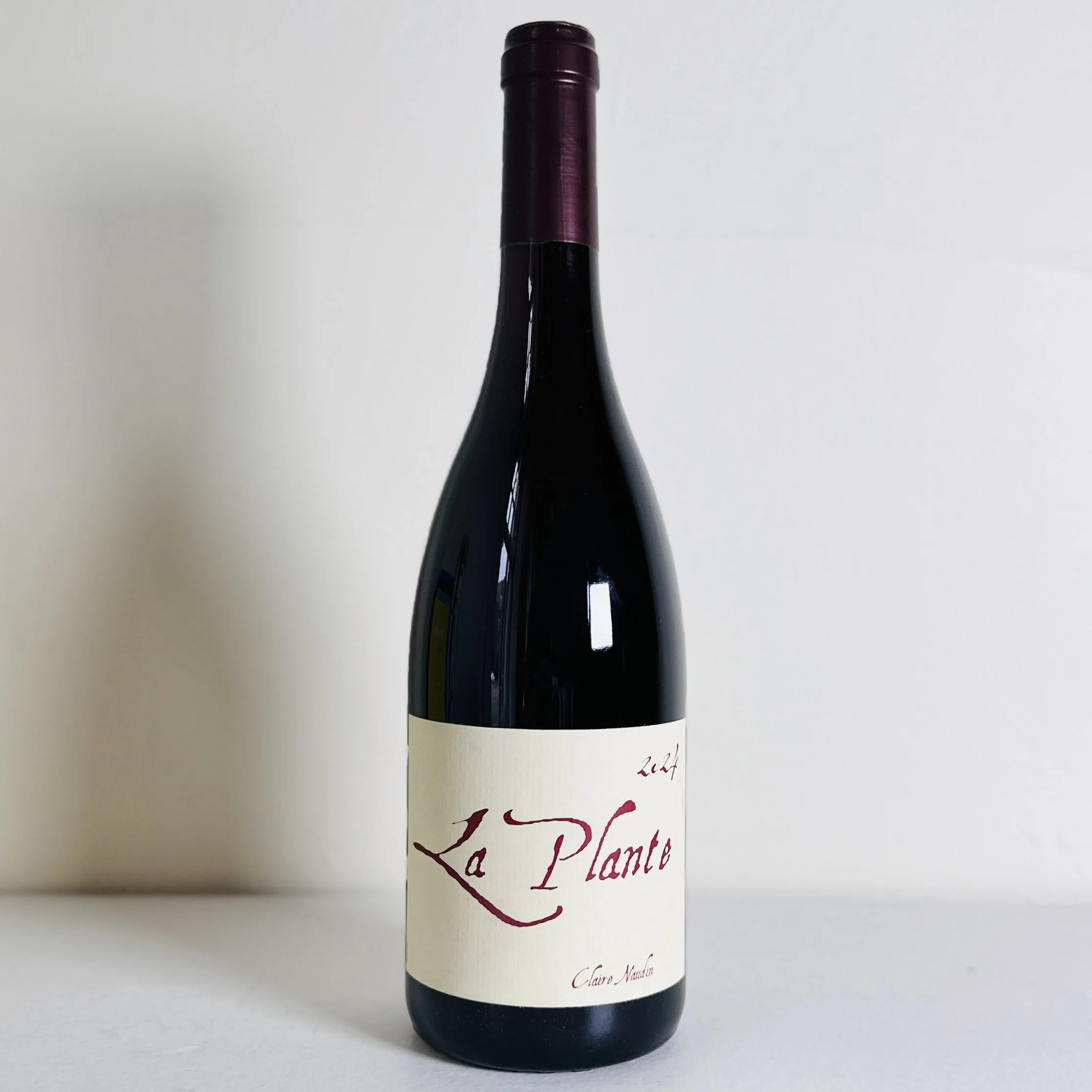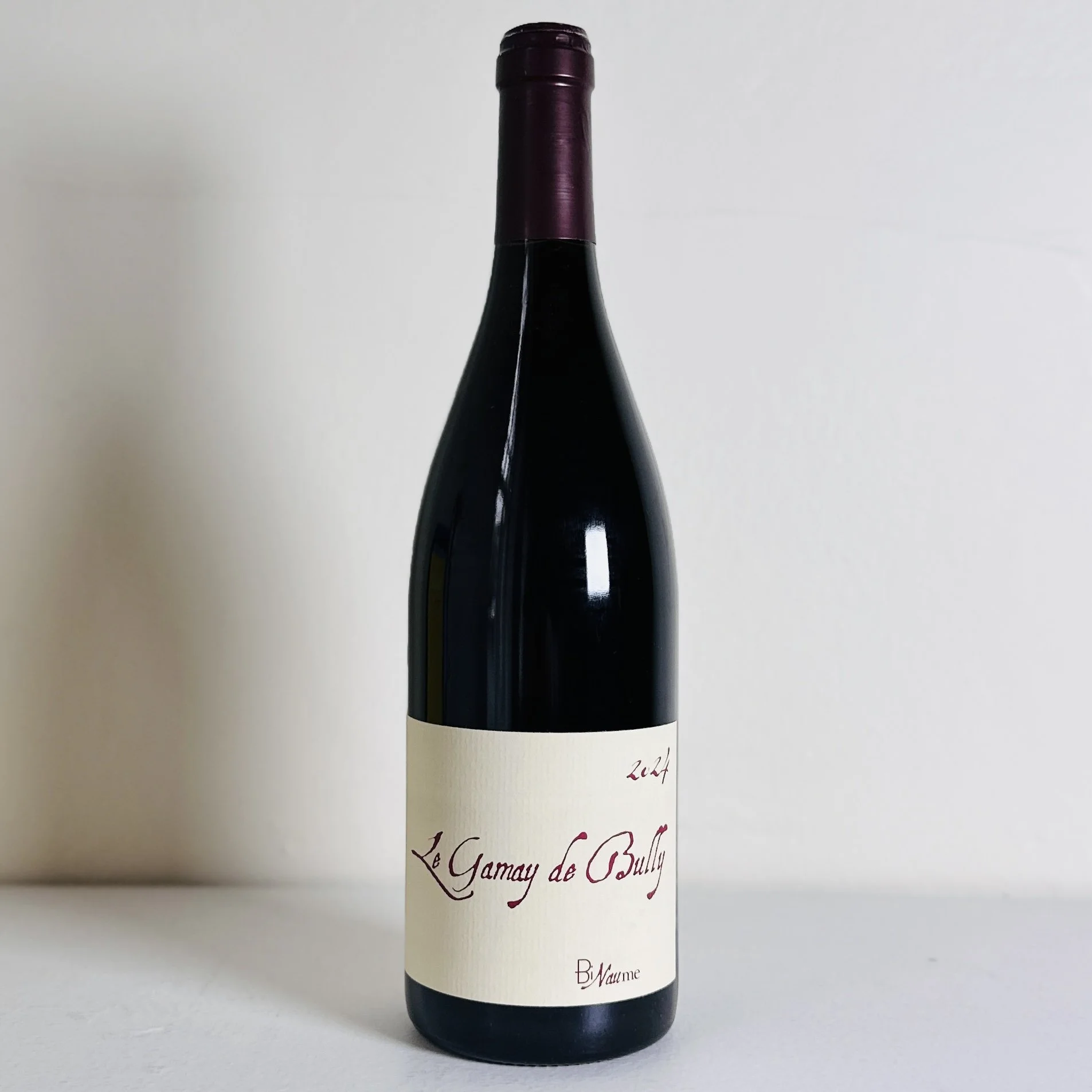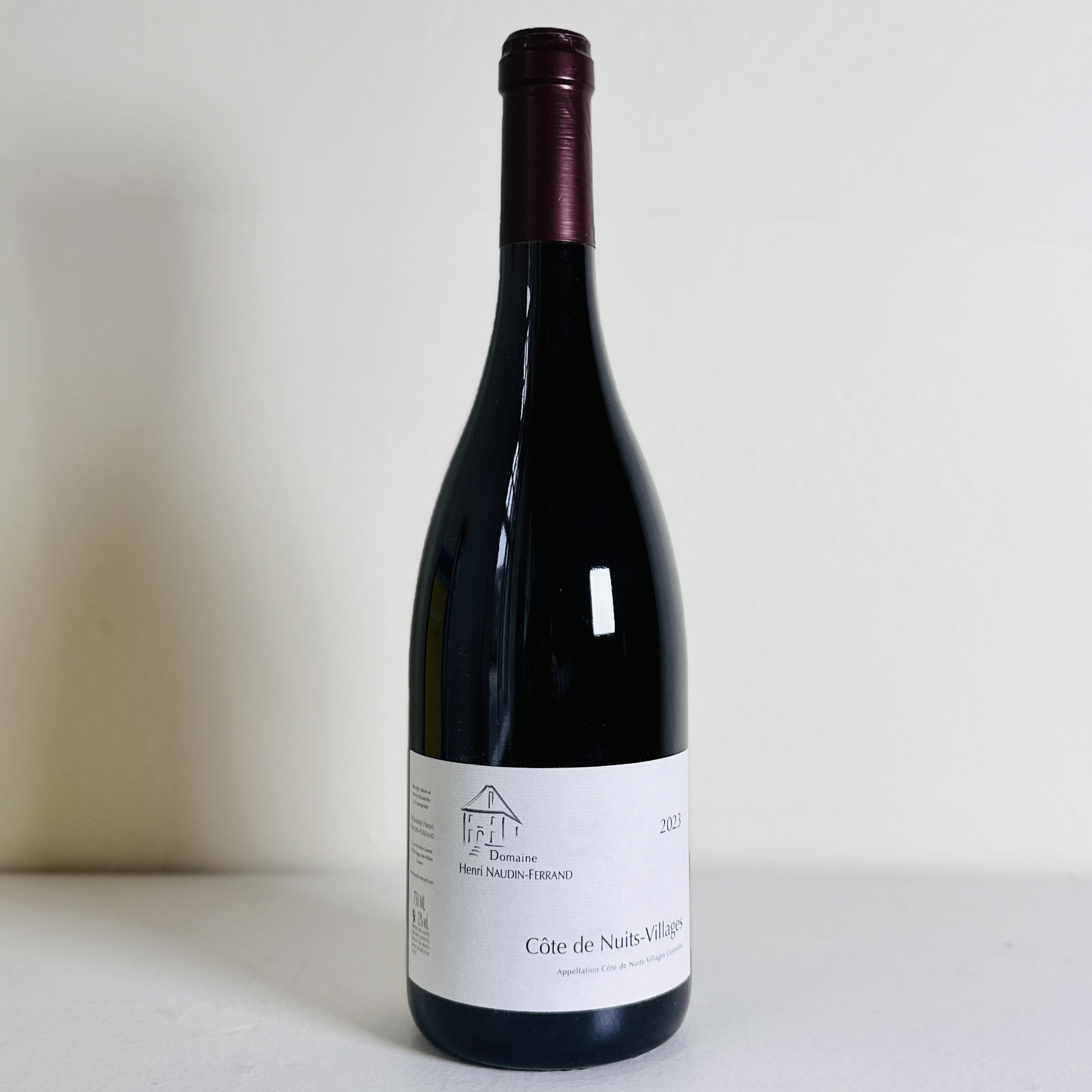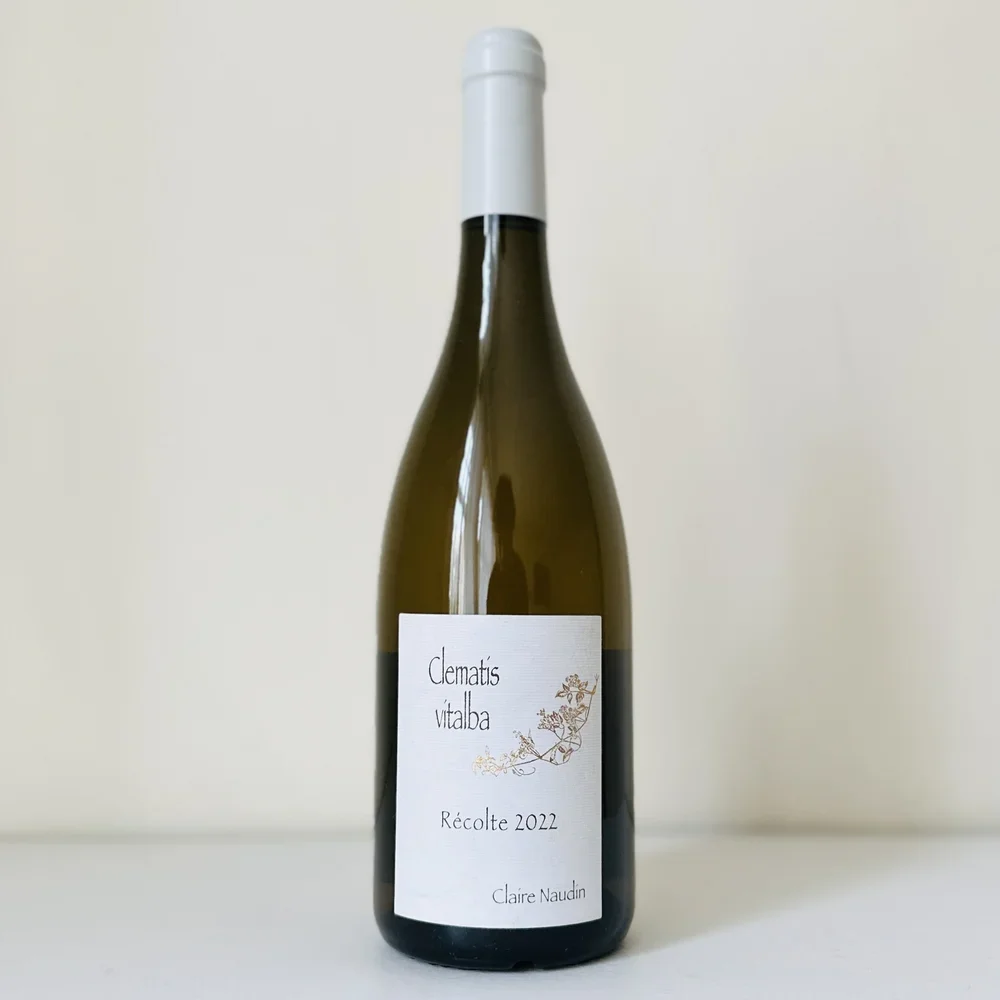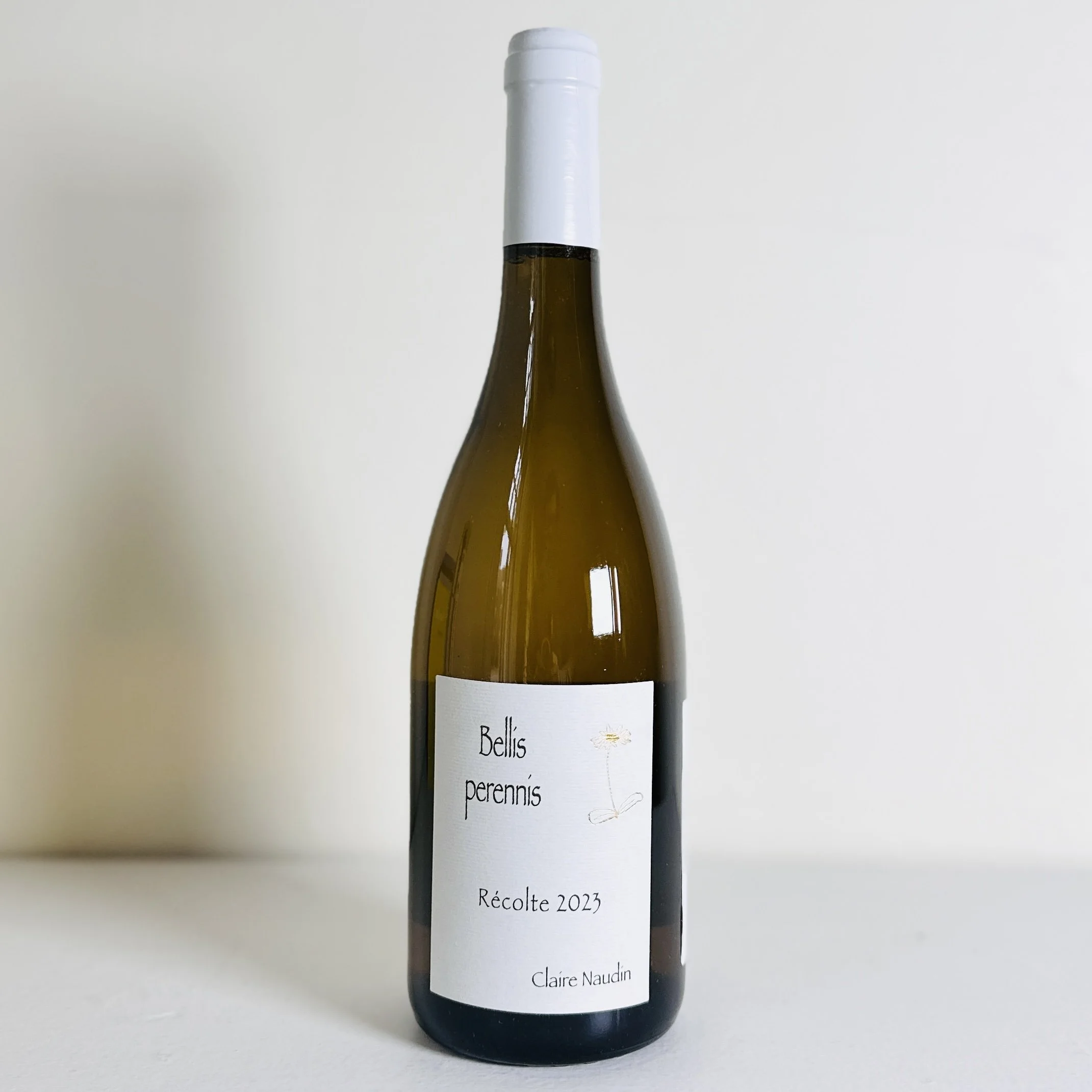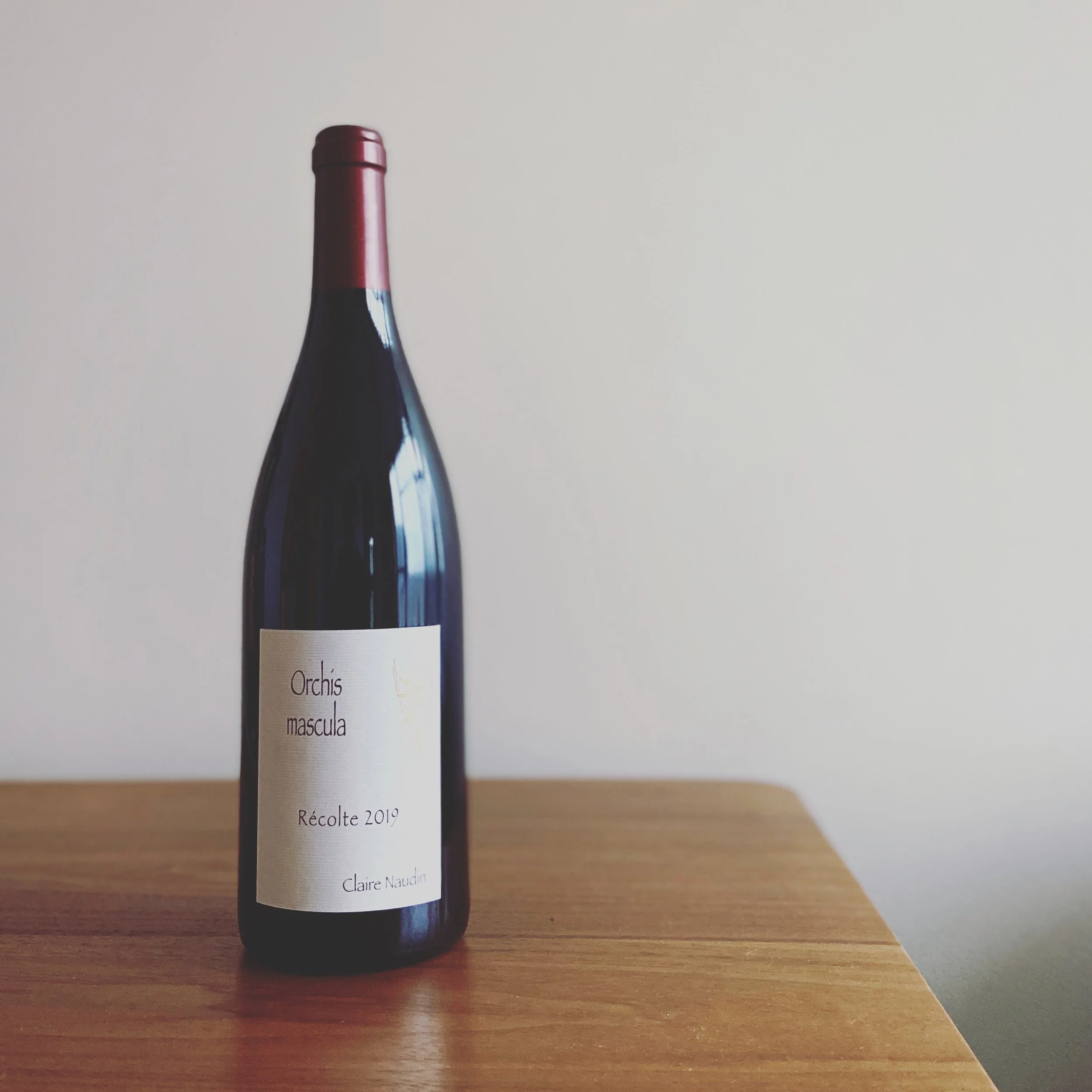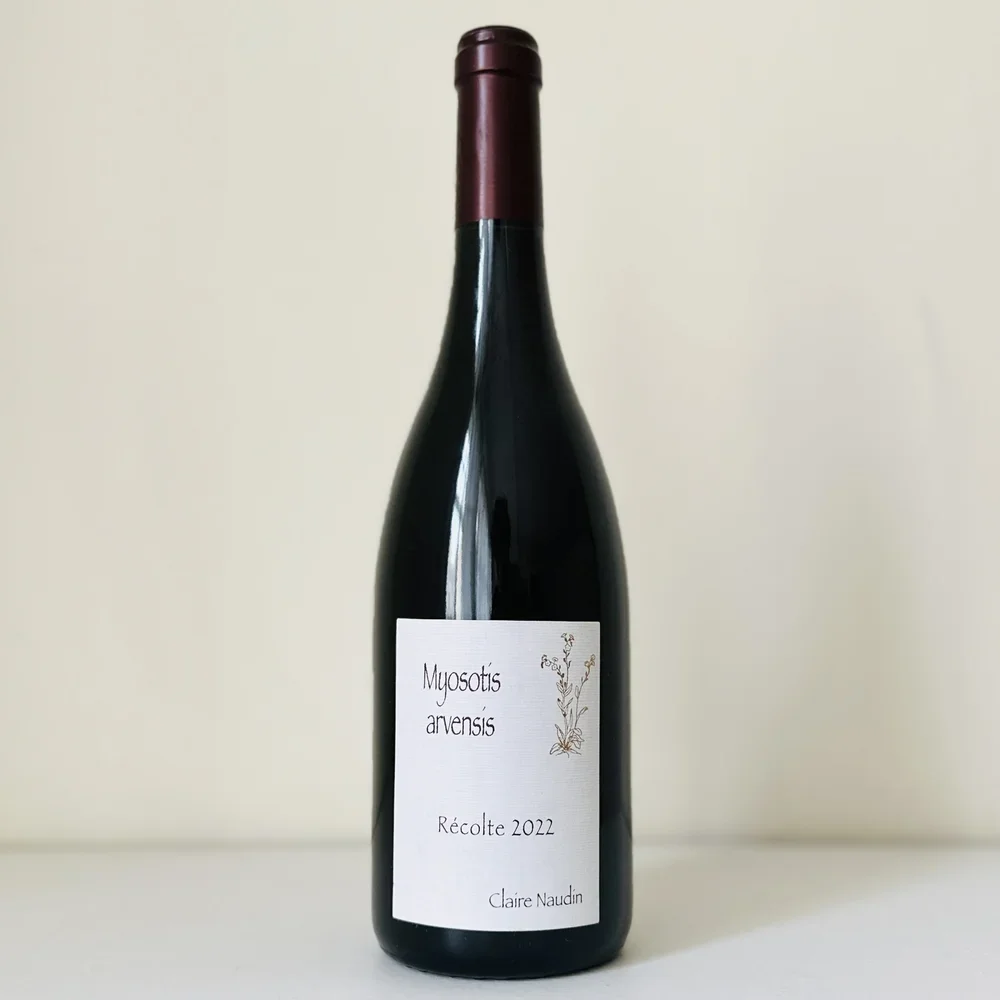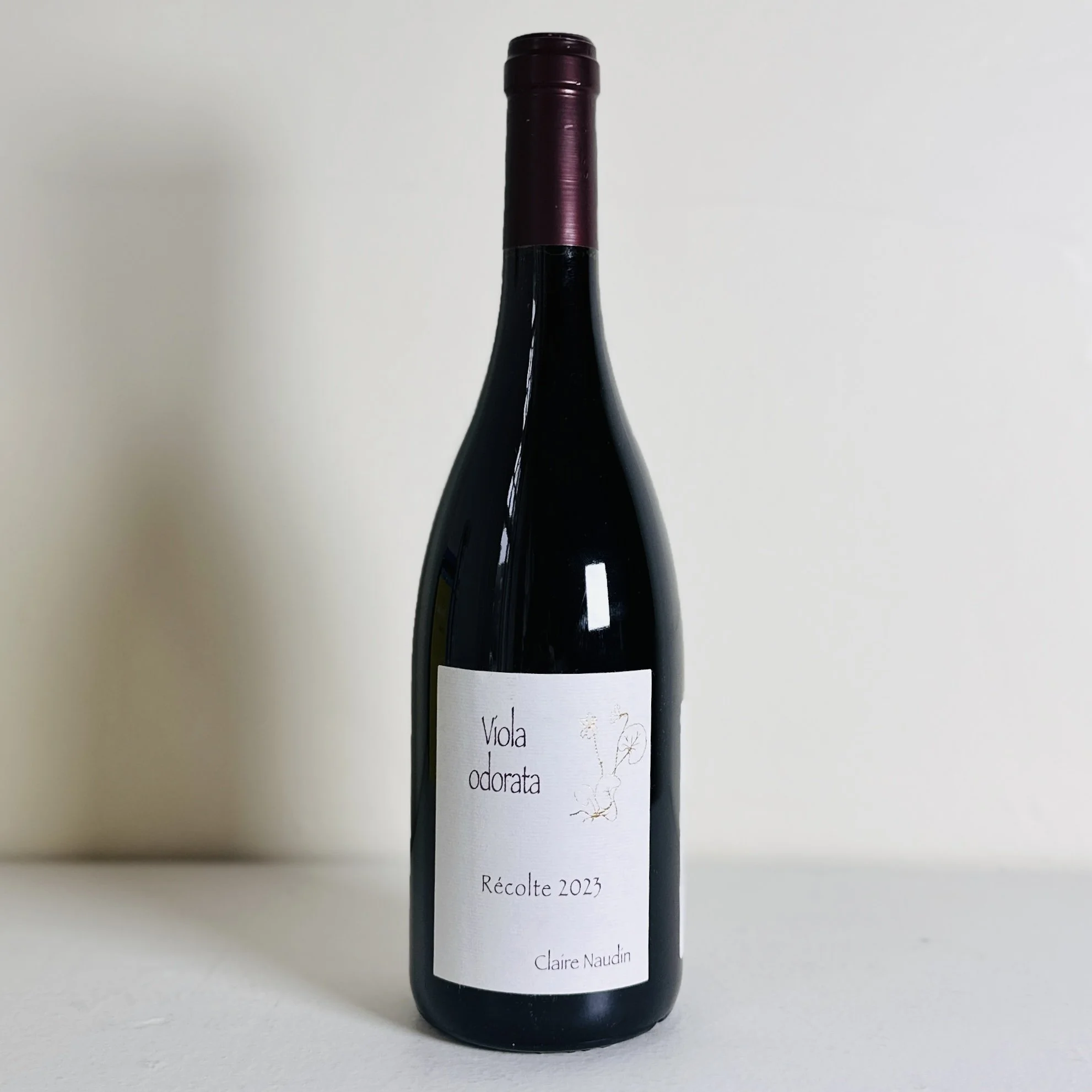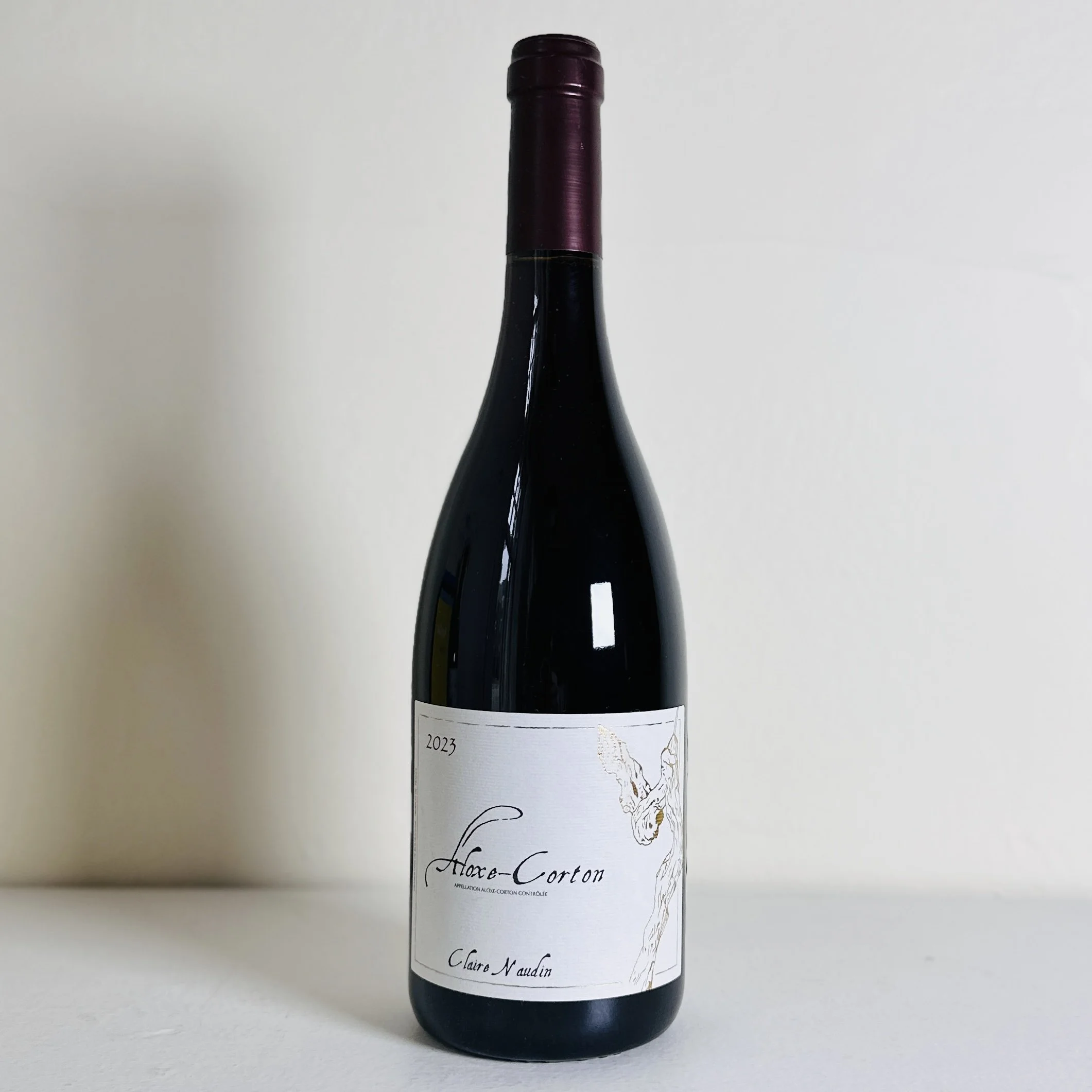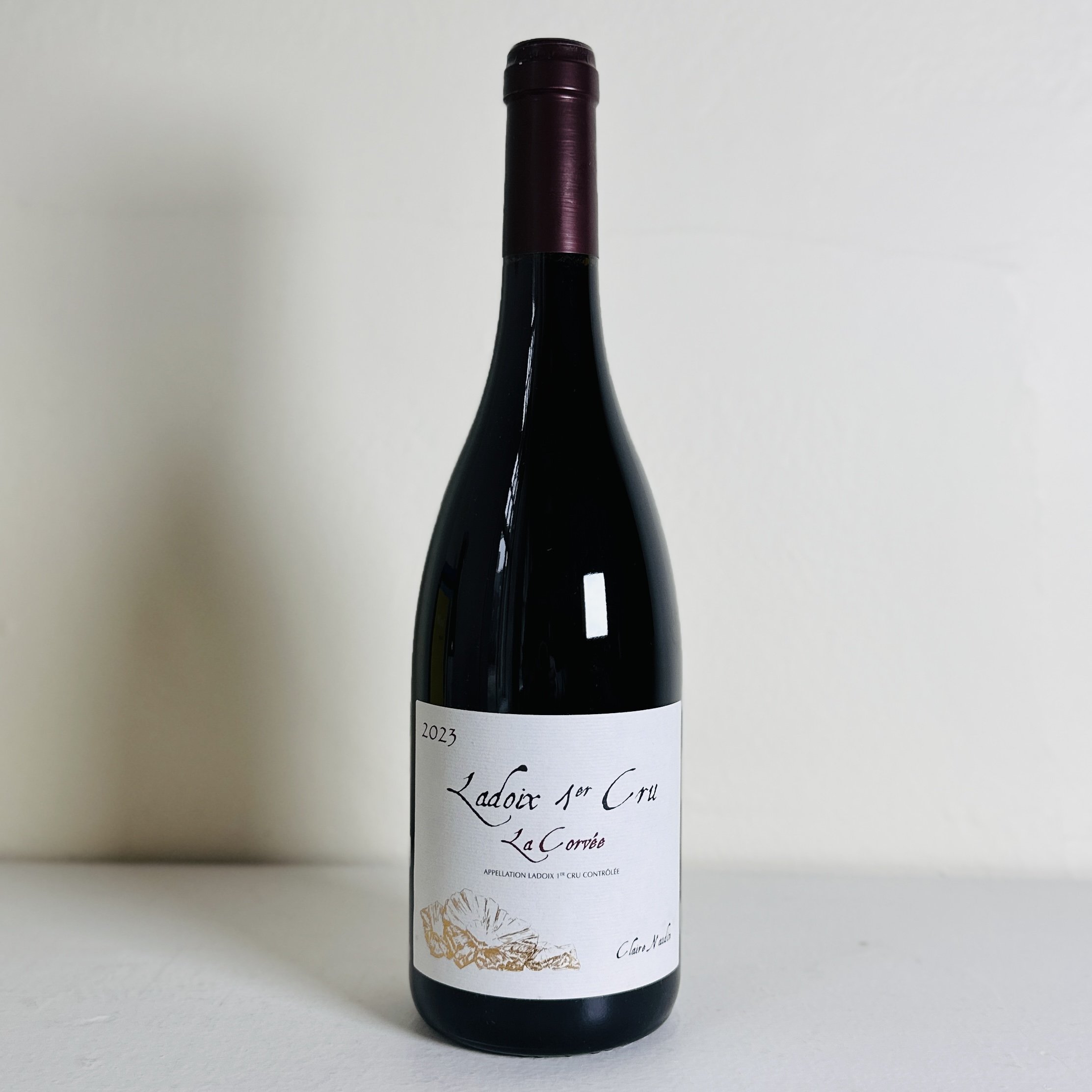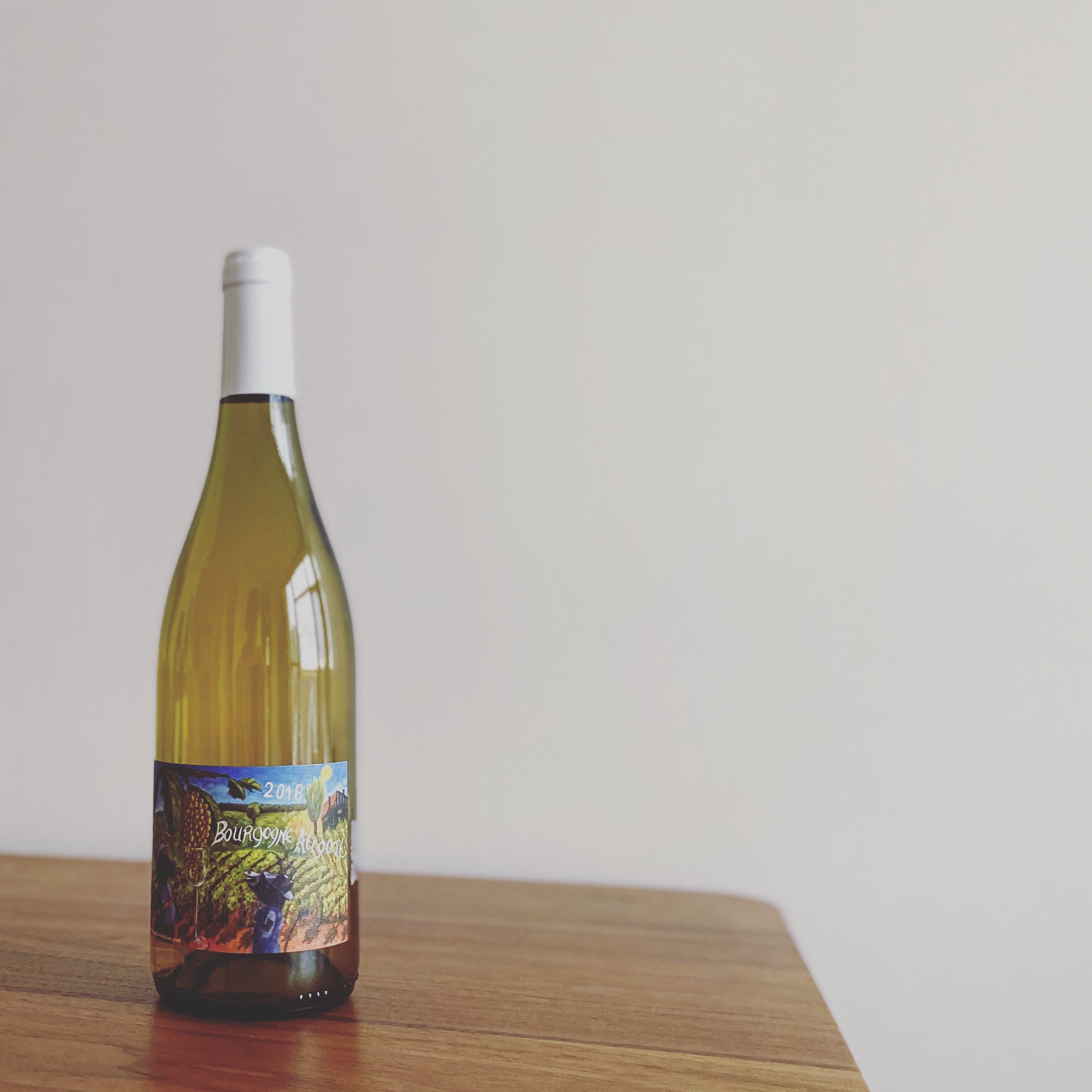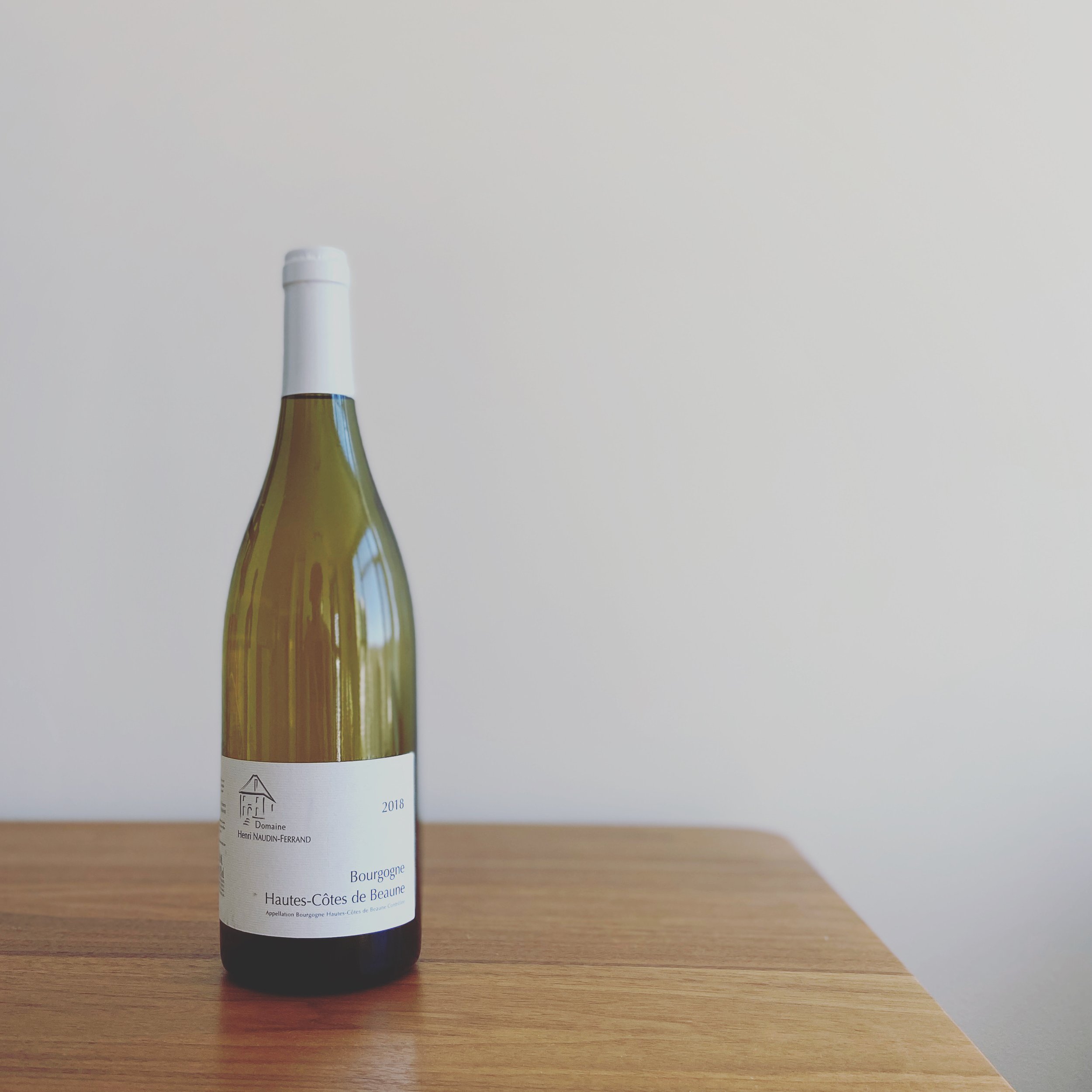CLAIRE NAUDIN PAST WINES
2022 LE CLOU 34
This wine is made from Aligoté grown around the town of Corgoloin in the Cote de Nuits. The majority come from a lieu-dit called Le Clou planted in 1934. The other sites that make it into the blend are Vallerot (1902), La Croix (1953), Castaings (1936), and Les Tilles (1935). These sites are planted on shallow limestone soils, usually facing east, in various training methods, including gobelets. The grapes are whole- cluster pressed, and the wine ages on full lees for texture. The wine is bottled by gravity, unfined, unfiltered, and with only a tiny amount of SO2 for travel when necessary. 12.5% ABV
2022 HAUTES-COTES BE BEAUNE BLANC
This cuvée is made from Chardonnay, and Pinot Blanc, a grape few remember is permitted in Burgundy. It comes from the lieu-dit of En Bully in the commune of Pernand-Vergelesses. The southeast-facing site was planted in 1969, with more Chardonnay being added in 2000 and 2001. The grapes are pressed into tank and barrel, some of which are new. Gentle batonnage is sometimes done during alcoholic fermentation. 60% of the wine is fined with bentonite clay for stability and clarity. The wine is lightly filtered as it is bottled by gravity, usually around 50ppm of total Sulphur. 13.0% ABV
2022 LA PLANTE
This cuvée comes from a tiny plot, En Daisey, in Magny-lès-Villiers, essentially outside any traditionally noteworthy appellation. Planted nearly forty years ago, these vines are trellised high to avoid spring frosts. The clay-limestones soils are more forgiving here, helping the grapes ripen. Whole clusters of Pinot Noir were added to tank and fermented without pump-overs for roughly two weeks before being pressed off. The wine is bottled without fining or filtration and with minimal SO2. 11.5% ABV
2023 GAMAY DE BULLY
This wine is grown by Claire’s friends Aurélie & Fabien Romany who were once interns at her winery. Their vineyard, located in Bully at the southern edge of Beaujolais, has been farmed organically since 2010. The soils are primarily sandy granite and volcanic between 300 and 400m above sea level. Some of the vines are incredibly old with most of the plantings occurring in the 50s and 60s. The grapes are brought to the winery in refrigerated truck before intense sorting for hail damaged berries and raisins. Whole clusters are fermented in concrete with minimal cap management. The wine is pressed off before fully dry to finish fermentation in Nomblot’s Dolia, an amphora shaped tank made from concrete. It is racked and bottled by gravity with minimal SO2. 13% ABV
2022 COTE-DE-NUITS VILLAGES
This cuvée comes from various sites around Corgoloin, the southern tip of the Cote-de-Nuits. Lieux-dits include En Vireville, la Montagne, Le Creux de Sobron, and Le Fourmeau. They’re almost exclusively facing east and are planted on classic limestone and clay. Vines range from 25-70 years old. The grapes were destemmed, and after a short cold maceration, the wine ferments on skins for two weeks with occasional pigeage and pump-overs. After a quick racking, the wine undergoes élevage in barrel, some of which were new. The wine is bottled unfiltered by gravity, with a small addition of Sulphur. 13.0% ABV
2022 CLEMATIS VITALBA
This cuvée comes from a small east facing lieu dit called Les Tilles in the Hautes-Cotes de Nuits next to Magny-lès-Villiers. Claire believes the calibre of this site allows her to make Chardonnay with little to no SO2. The 25-year-old vines yield particularly ripe and balanced fruit. The grapes were gently whole-cluster pressed into tank. After a short settling period, the juice is racked into both new and neutral barrels for fermentation and élevage. 13.5% ABV
2022 BELLIS PERENNIS
This wine comes from two of Claire’s most prized parcels: En Daisey in Magny lès Villers, and En Bully (named for its bubbling spring) in Pernand-Vergelesses. Whole clusters were gently pressed into tank for a short settling period. The juice is then racked into barrel for fermentation. The wine is only ever moved by gravity, not by pump. After a yearlong élevage on the fine lees the wine is bottled unfiltered with just over 20ppm of SO2. It is an ode to the daisies found in her vineyards. 13.0% ABV
2022 GALANTHUS NIVALIS
Claire has less than a half hectare of Pinot Blanc planted in her prized site, En Daisey, in Magny lès Villers above Pernand Vergelesses. The vines were gifted to her father in 1969 by the Gouges family. Historically, Claire has blended Pinot Blanc with Chardonnay from the same site, but a severe frost in 2016 killed all the Chardonnay buds. She decided to bottle the Pinot Blanc separately. The results were so good that she’s kept it separate ever since. The grapes are direct pressed into barrel for fermentation and élevage. The wine is bottled unfined and unfiltered.
2022 ORCHIS MASCULA
This cuvée comes from three exceptional sites in the Hautes-Cotes de Beaune: En Bully (50-year-old vines), La Grande Corvée de Bully (18-year-old vines), and En Foigery (16-year-old vines). You can reach them by following the road past Pernand-Vergelesses, around the back of the hill of Corton, and up into the hills. The south and south-east facing sites were recognized as prime by Claire’s father in the 60s and now yield one of her most iconic wines. The grapes undergo five days of carbonic maceration before ten days of pigeage. The wine is then pressed into a combination of new and old barrels for élevage. It is bottled unfined, unfiltered, and with minimal SO2.
2022 MYOSOTIS ARVENSIS
.After five years working with Claire, we’ve finally received an allocation of this cuvée. It comes from four lieu-dits in the Hautes-Cotes de Nuits: Les Tilles, La Croix, Les Chaumes, and le Champ Lavoca. Vines range from 7 to 74 years old, giving this wine both youthful verve and mature wisdom. The grapes undergo five days of carbonic maceration before ten days of pigeage. The wine is then pressed into a combination of new and old barrels for élevage. It is bottled unfined, unfiltered, and with minimal SO2. 13% ABV
2022 VIOLA ODORATA
This wine comes from up to five lieu-dits near Corgoloin, the southern extremity of the Cote de Nuits: En Vireville, En Fontenelle, Le Creux de Sobron, La Montagne, and Le Forneau. Vine age ranges from 55 to 115 years old. The eastern exposure is ideal for producing maximally ripe Pinot Noir. The grapes undergo five days of carbonic maceration before ten days of pigeage. The wine is then pressed into a combination of new and old barrels for élevage. It is bottled unfined, unfiltered, and with minimal SO2.
2022 ALOXE-CORTON
These are Claire’s oldest living vines. 2/3 of the vineyard is 64 years old, while the remainder is 115. They can be found in the lieu-dit of Les Crapousuets, a gently sloped east-facing site on typical clay and limestone. The grapes undergo five days of carbonic maceration before ten days of pigeage. The wine is then pressed into a combination of new and old barrels for élevage. It is bottled unfined, unfiltered, and with minimal SO2. Production for this cuvée is so small that this is our second allocation in six years. 12% ABV
2022 LADOIX 1er CRU
La Corvée is the furthest north premier cru of the Cote de Beaune. Located on a purely south facing slope on well drained soils, it shares some similarities with its more prestigious neighbors Aloxe-Corton and Pernand-Vergelesses. The site tends to ripen evenly every year, tending towards over-ripeness rather than under-ripeness. 2/3 of the vineyard was planted in 1955 with selection massale while the other 1/3 was planted in 1987 with regional clones. The grapes undergo whole-cluster semi-carbonic maceration with gentle pigeage. It is then pressed off into barrel, many of which are new or second fill. After élevage on fine lees the wine is bottled by gravity without any pumping. It is unfined, unfiltered, and has no added Sulphur. Less than 200 cases are made per year. 12.0% ABV
2022 NUITS-ST-GEORGES 1er CRU
Les Damodes is a steep premier cru featuring exposed limestone bedrock perched above the town of Nuits-St-Georges. It is located in the far northern corner of the appellation, only 2-300m away from La Tâche. The vines are 50-80 years old and are facing due east. The grapes were fermented whole-cluster in tank for roughly two weeks before being pressed off into barrel, many of which were new or second fill. After élevage on fine lees the wine is bottled by gravity without any pumping. It is unfined, unfiltered, and has no added Sulphur. Less than 100 cases are made per year. 13.0% ABV
2022 ECHÉZEAUX GRAND CRU
The lieu-dit of Les Rouges du Bas is roughly one acre near the top on the slope. Soils here include sandy pink limestone making it incredibly unique. The steep slope and modest topsoil mean cover crops are essential for preventing erosion. The vines are roughly forty years old. Claire typically harvests this plot early in the morning to retain freshness, opting for whole-cluster fermentation for two weeks in an open-top tank. She employs gentle pigeage to avoid over-extraction. The wine is then pressed off into barrel, many of which are new. One month before bottling, she racks into stainless steel, then bottles via gravity without fining or filtration. In a typical year, 100 cases are produced. 13.0% ABV
2021 ALIGOTÉ
This cuvée comes from Magny lès Villers and Villers la Faye, two sites perfect for Aligoté: shallow topsoil, mostly flat, and plenty of sunshine thanks to their south-east orientation. The grapes are pressed into stainless steel and enameled tank for fermentation and élevage on fine lees. No batonnage is done during the short seven-month élevage. The wine is fined with bentonite clay for stability and clarity and then lightly filtered before bottling via gravity. A small amount is Sulphur is added at bottling (usually less than 50ppm total SO2).
2021 LE CLOU 34
This wine is made from Aligoté grown around the town of Corgoloin in the Cote de Nuits. The majority come from a lieu-dit called Le Clou planted in 1934. The other sites that make it into the blend are Vallerot (1902), La Croix (1953), Castaings (1936), and Les Tilles (1935). These sites are planted on shallow limestone soils, usually facing east, in various training methods, including gobelets. The grapes are whole- cluster pressed, and the wine ages on full lees for texture. The wine is bottled by gravity, unfined, unfiltered, and with only a tiny amount of SO2 for travel when necessary.
2021 HAUTES-COTES BE BEAUNE BLANC
This cuvée is made from Chardonnay, and Pinot Blanc, a grape few remember is permitted in Burgundy. It comes from the lieu-dit of En Bully in the commune of Pernand-Vergelesses. The southeast-facing site was planted in 1969, with more Chardonnay being added in 2000 and 2001. The grapes are pressed into tank and barrel, some of which are new. Gentle batonnage is sometimes done during alcoholic fermentation. 60% of the wine is fined with bentonite clay for stability and clarity. The wine is lightly filtered as it is bottled by gravity, usually around 50ppm of total Sulphur.
2022 LA PLANTE
This cuvée comes from a tiny plot, En Daisey, in Magny-lès-Villiers, essentially outside any traditionally noteworthy appellation. Planted nearly forty years ago, these vines are trellised high to avoid spring frosts. The clay-limestones soils are more forgiving here, helping the grapes ripen. Whole clusters of Pinot Noir were added to tank and fermented without pump-overs for roughly two weeks before being pressed off. The wine is bottled without fining or filtration and with minimal SO2.
2021 CLEMATIS VITALBA
This cuvée comes from a small east facing lieu dit (Les Tilles) in Magny-lès-Villiers. Claire believes this is her best site, allowing her to make a Chardonnay without added SO2. The 25-year-old vines yielded particularly ripe and balanced fruit this vintage. The grapes were gently whole-cluster pressed into tank before the juice was racked into barrel. After a year-long élevage in 30% new oak, the wine is bottled unfiltered.
2021 COTE-DE-NUITS VILLAGES
This cuvée comes from various sites around Corgoloin, the southern tip of the Cote-de-Nuits. Lieux-dits include En Vireville, la Montagne, Le Creux de Sobron, and Le Fourmeau. They’re almost exclusively facing east and are planted on classic limestone and clay. Vines range from 25-70 years old. The grapes were destemmed, and after a short cold maceration, the wine ferments on skins for two weeks with occasional pigeage and pump-overs. After a quick racking, the wine undergoes élevage in barrel, some of which were new. The wine is bottled unfiltered by gravity, with a small addition of Sulphur.
2021 ORCHIS MASCULA
This cuvée comes from three exceptional sites in the Hautes-Cotes de Beaune: En Bully (47-year-old vines), La Grande Corvée de Bully (15-year-old vines), and En Foigery (13-year-old vines). After five days of carbonic maceration, the grapes are gently crushed by foot. They avoid pumping the wine to prevent oxidation, a risk when fermenting without any added Sulphur. After ten days on skins, the wine is gently pressed into barrel, some of which are new. The wine is bottled unfined, unfiltered, and only with a tiny amount of SO2 for travel when necessary.
2021 VIOLA ODORATA
This wine comes from five lieu-dits near Corgoloin, between Burgundy’s Côte de Nuits and Côte de Beaune: En Vireville, En Fontenelle, Le Creux de Sobron, La Montange, and Le Forneau. Vine age ranges from 55 to 115 years old. The eastern exposure is ideal for producing maximally ripe Pinot Noir. Whole berry fermentation occurs under a layer of CO2 before the grapes undergo gentle pigeage to extract phenolics gently. After two weeks of fermentation, the wine is pressed off and moved via gravity to tank. After a two day settling off gross lees, the wine is transferred to barrels, one-third of which were new. It is bottled unfined and unfiltered with around 20ppm of SO2. Seven hundred cases were produced.
2021 LADOIX 1er CRU
La Corvée is the furthest north premier cru of the Cote de Beaune. Located on a purely south facing slope on well drained soils, it shares some similarities with its more prestigious neighbors Aloxe-Corton and Pernand-Vergelesses. The site tends to ripen evenly every year, tending towards over-ripeness rather than under-ripeness. 2/3 of the vineyard was planted in 1955 with selection massale while the other 1/3 was planted in 1987 with regional clones. The grapes undergo whole-cluster semi-carbonic maceration with gentle pigeage. It is then pressed off into barrel, many of which are new or second fill. After élevage on fine lees the wine is bottled by gravity without any pumping. It is unfined, unfiltered, and has no added Sulphur. Less than 200 cases are made per year.
2020 NUITS-ST-GEORGES 1er CRU
Les Damodes is a steep premier cru featuring exposed limestone bedrock perched above the town of Nuits-St-Georges. It is located in the far northern corner of the appellation, only 2-300m away from La Tâche. The vines are 50-80 years old and are facing due east. The grapes were fermented whole-cluster in tank for roughly two weeks before being pressed off into barrel, many of which were new or second fill. After élevage on fine lees the wine is bottled by gravity without any pumping. It is unfined, unfiltered, and has no added Sulphur. Less than 100 cases are made per year.
2021 ÉCHEZEAUX GRAND CRU
The lieu-dit of Les Rouges du Bas is roughly one acre near the top on the slope. Soils here include sandy pink limestone making it incredibly unique. The steep slope and modest topsoil mean cover crops are essential for preventing erosion. The vines are roughly forty years old. Claire typically harvests this plot early in the morning to retain freshness, opting for whole-cluster fermentation for two weeks in an open-top tank. She employs gentle pigeage to avoid over-extraction. The wine is then pressed off into barrel, many of which are new. One month before bottling, she racks into stainless steel, then bottles via gravity without fining or filtration. In a typical year, 100 cases are produced.
2020 BELLIS PERENNIS
This wine comes from two of Claire’s most prized parcels: En Daisey in Magny lès Villers, and En Bully (named for its bubbling spring) in Pernand-Vergelesses. Whole clusters were gently pressed into tank for a short settling period. The juice is then racked into barrel for fermentation. The wine is only ever moved by gravity, not by pump. After a yearlong élevage on the fine lees the wine is bottled unfiltered with just over 20ppm of SO2. It is an ode to the daisies found in her vineyards.
2021 LE GAMAY DE L’ALLIÉ
This project started after several devastating vintages in Burgundy. Claire decided to seek out vineyards to supplement her production. She opted for a site nearly 200km east of Beaune in St Pourcain planted to Gamay. With pink granite soils it is not unlike Beaujolais. After the grapes arrive in refrigerated trucks, they are fermented as whole-clusters in concrete without any pump-overs. This was the first wine she ever bottled entirely without Sulphur. It is unfined and unfiltered.
2020 ALIGOTÉ
This cuvée comes from Magny lès Villers and Villers la Faye, two sites perfect for Aligoté: shallow topsoil, mostly flat, and plenty of sunshine thanks to their south-east orientation. The grapes are pressed into stainless steel and enameled tank for fermentation and élevage on fine lees. No batonnage is done during the short seven-month élevage. The wine is fined with bentonite clay for stability and clarity and then lightly filtered before bottling via gravity. A small amount is Sulphur is added at bottling (usually less than 50ppm total SO2).
2020 LE CLOU 34
This wine is made from Aligoté grown around the town of Corgoloin in the Cote de Nuits. The majority come from a lieu-dit called Le Clou planted in 1934. The other sites that make it into the blend are Vallerot (1902), La Croix (1953), Castaings (1936), and Les Tilles (1935). These sites are planted on shallow limestone soils, usually facing east, in various training methods, including gobelets. The grapes are whole- cluster pressed, and the wine ages on full lees for texture. The wine is bottled by gravity, unfined, unfiltered, and with only a tiny amount of SO2 for travel when necessary.
2020 HAUTES-COTES DE BEAUNE BLANC
This cuvée is made from 62% Chardonnay, and 38% Pinot Blanc, a grape few remember is permitted in Burgundy. It comes from the lieu-dit of En Bully in the commune of Pernand-Vergelesses. The southeast-facing site was planted in 1969, with more Chardonnay being added in 2000 and 2001. The grapes are pressed into tank and barrel, some of which are new. Gentle batonnage is sometimes done during alcoholic fermentation. 60% of the wine is fined with bentonite clay for stability and clarity. The wine is lightly filtered as it is bottled by gravity, usually around 50ppm of total Sulphur.
2021 LA PLANTE
This cuvée comes from a tiny plot, En Daisey, in Magny-lès-Villiers, essentially outside any traditionally noteworthy appellation. Planted nearly forty years ago, these vines are trellised high to avoid spring frosts. The clay-limestones soils are more forgiving here, helping the grapes ripen. Whole clusters of Pinot Noir were added to tank and fermented without pump-overs for roughly two weeks before being pressed off. The wine is bottled without fining or filtration and with minimal SO2.
2020 COTE-DE-NUITS VILLAGES
This cuvée comes from various sites around Corgoloin, the southern tip of the Cote-de-Nuits. Lieux-dits include En Vireville, la Montagne, Le Creux de Sobron, and Le Fourmeau. They’re almost exclusively facing east and are planted on classic limestone and clay. Vines range from 25-70 years old. The grapes were destemmed, and after a short cold maceration, the wine ferments on skins for two weeks with occasional pigeage and pump-overs. After a quick racking, the wine undergoes élevage in barrel, some of which were new. The wine is bottled unfiltered by gravity, with a small addition of Sulphur.
2020 ORCHIS MASCULA
This cuvée comes from three exceptional sites in the Hautes-Cotes de Beaune: En Bully (46-year-old vines), La Grande Corvée de Bully (14-year-old vines), and En Foigery (12-year-old vines). After five days of carbonic maceration, the grapes are gently crushed by foot. They avoid pumping the wine to prevent oxidation, a risk when fermenting without any added Sulphur. After ten days on skins, the wine is gently pressed into barrel, some of which are new. The wine is bottled unfined, unfiltered, and only with a tiny amount of SO2 for travel when necessary.
2018 VIOLA ODORATA
This wine comes from five lieu-dits near Corgoloin, between Burgundy’s Côte de Nuits and Côte de Beaune: En Vireville, En Fontenelle, Le Creux de Sobron, La Montange, and Le Forneau. Vine age ranges from 55 to 115 years old. The eastern exposure is ideal for producing maximally ripe Pinot Noir. Whole berry fermentation occurs under a layer of CO2 before the grapes undergo gentle pigeage to extract phenolics gently. After two weeks of fermentation, the wine is pressed off and moved via gravity to tank. After a two day settling off gross lees, the wine is transferred to barrels, one-third of which were new. It is bottled unfined and unfiltered with around 20ppm of SO2. Seven hundred cases were produced.
2020 CLEMATIS VITALBA
This cuvée comes from a small east facing lieu dit (Les Tilles) in Magny-lès-Villiers. Claire believes this is her best site, allowing her to make a Chardonnay without added SO2. The 25-year-old vines yielded particularly ripe and balanced fruit this vintage. The grapes were gently whole-cluster pressed into tank before the juice was racked into barrel. After a year-long élevage in 30% new oak, the wine is bottled unfiltered.
2020 LADOIX 1ER CRU
La Corvée is the furthest north premier cru of the Cote de Beaune. Located on a purely south facing slope on well drained soils, it shares some similarities with its more prestigious neighbors Aloxe-Corton and Pernand-Vergelesses. The site tends to ripen evenly every year, tending towards over-ripeness rather than under-ripeness. 2/3 of the vineyard was planted in 1955 with selection massale while the other 1/3 was planted in 1987 with regional clones. The grapes undergo whole-cluster semi-carbonic maceration with gentle pigeage. It is then pressed off into barrel, many of which are new or second fill. After élevage on fine lees the wine is bottled by gravity without any pumping. It is unfined, unfiltered, and has no added Sulphur. Less than 200 cases are made per year.
2020 ÉCHEZEAUX GRAND CRU
The lieu-dit of Les Rouges du Bas is roughly one acre near the top on the slope. Soils here include sandy pink limestone making it incredibly unique. The steep slope and modest topsoil mean cover crops are essential for preventing erosion. The vines are roughly forty years old. Claire typically harvests this plot early in the morning to retain freshness, opting for whole-cluster fermentation for two weeks in an open-top tank. She employs gentle pigeage to avoid over-extraction. The wine is then pressed off into barrel, many of which are new. One month before bottling, she racks into stainless steel, then bottles via gravity without fining or filtration. In a typical year, 100 cases are produced.
2019 ALIGOTÉ
This cuvée comes from Magny lès Villers and Villers la Faye, two sites perfect for Aligoté: shallow topsoil, mostly flat, and plenty of sunshine thanks to their south-east orientation. The grapes are pressed into stainless steel and enameled tank for fermentation and élevage on fine lees. No batonnage is done during the short seven-month élevage. The wine is fined with bentonite clay for stability and clarity and then lightly filtered before bottling via gravity. A small amount is Sulphur is added at bottling (usually less than 50ppm total SO2). 12.5% ABV
2019 LE CLOU 34
This wine is made from Aligoté grown around the town of Corgoloin in the Cote de Nuits. The majority come from a lieu-dit called Le Clou planted in 1934. The other sites that make it into the blend are Vallerot (1902), La Croix (1953), Castaings (1936), and Les Tilles (1935). These sites are planted on shallow limestone soils, usually facing east, in various training methods, including gobelets. The grapes are whole- cluster pressed, and the wine ages on full lees for texture. The wine is bottled by gravity, unfined, unfiltered, and with only a tiny amount of SO2 for travel when necessary.
2019 ALIBULLE
This wine comes from Claire’s youngest Aligoté vines. The grapes are destemmed and pressed into stainless steel for fermentation and malolactic conversion. After ten months on lees the wine is racked and bottled. They’ve captured a little CO2 resultingly in a modestly prickly wine
2019 HAUTES-COTES DE BEAUNE BLANC
This cuvée is made from 62% Chardonnay, and 38% Pinot Blanc, a grape few remember is permitted in Burgundy. It comes from the lieu-dit of En Bully in the commune of Pernand-Vergelesses. The southeast-facing site was planted in 1969, with more Chardonnay being added in 2000 and 2001. The grapes are pressed into tank and barrel, some of which are new. Gentle batonnage is sometimes done during alcoholic fermentation. 60% of the wine is fined with bentonite clay for stability and clarity. The wine is lightly filtered as it is bottled by gravity, usually around 50ppm of total Sulphur. Roughly 500 cases were made. 13% ABV
2020 LE GAMAY DE L’ALLIÉ
This project started after several devastating vintages in Burgundy. Claire decided to seek out vineyards to supplement her production. She opted for a site nearly 200km east of Beaune in St Pourcain planted to Gamay. With pink granite soils it is not unlike Beaujolais. After the grapes arrive in refrigerated trucks, they are fermented as whole-clusters in concrete without any pump-overs. This was the first wine she ever bottled entirely without Sulphur. It is unfined and unfiltered. 12.5% ABV
2019 COTE-DE-NUITS VILLAGES
This cuvée comes from various sites around Corgoloin, the southern tip of the Cote-de-Nuits. Lieux-dits include En Vireville, la Montagne, Le Creux de Sobron, and Le Fourmeau. They’re almost exclusively facing east and are planted on classic limestone and clay. Vines range from 25-70 years old. The grapes were destemmed, and after a short cold maceration, the wine ferments on skins for two weeks with occasional pigeage and pump-overs. After a quick racking, the wine undergoes élevage in barrel, some of which were new. The wine is bottled unfiltered by gravity, with a small addition of Sulphur.
2019 ORCHIS MASCULA
This cuvée comes from three exceptional sites in the Hautes-Cotes de Beaune: En Bully (46-year-old vines), La Grande Corvée de Bully (14-year-old vines), and En Foigery (12-year-old vines). After five days of carbonic maceration, the grapes are gently crushed by foot. They avoid pumping the wine to prevent oxidation, a risk when fermenting without any added Sulphur. After ten days on skins, the wine is gently pressed into barrel, some of which are new. The wine is bottled unfined, unfiltered, and only with a tiny amount of SO2 for travel when necessary.
2019 LADOIX 1ER CRU
La Corvée is the furthest north premier cru of the Cote de Beaune. Located on a purely south facing slope on well drained soils, it shares some similarities with its more prestigious neighbors Aloxe-Corton and Pernand-Vergelesses. The site tends to ripen evenly every year, tending towards over-ripeness rather than under-ripeness. 2/3 of the vineyard was planted in 1955 with selection massale while the other 1/3 was planted in 1987 with regional clones. The grapes undergo whole-cluster semi-carbonic maceration with gentle pigeage. It is then pressed off into barrel, many of which are new or second fill. After élevage on fine lees the wine is bottled by gravity without any pumping. It is unfined, unfiltered, and has no added Sulphur. Less than 200 cases are made per year.
2019 NUITS-ST-GEORGES 1ER CRU
Les Damodes is a steep premier cru featuring exposed limestone bedrock perched above the town of Nuits-St-Georges. It is located in the far northern corner of the appellation, only 2-300m away from La Tâche. The vines are 50-80 years old and are facing due east. The grapes were fermented whole-cluster in tank for roughly two weeks before being pressed off into barrel, many of which were new or second fill. After élevage on fine lees the wine is bottled by gravity without any pumping. It is unfined, unfiltered, and has no added Sulphur. Less than 100 cases are made per year.
2018 VIOLA ODORATA
This wine comes from five lieu-dits near Corgoloin, between Burgundy’s Côte de Nuits and Côte de Beaune: En Vireville, En Fontenelle, Le Creux de Sobron, La Montange, and Le Forneau. Vine age ranges from 55 to 115 years old. The eastern exposure is ideal for producing maximally ripe Pinot Noir. Whole berry fermentation occurs under a layer of CO2 before the grapes undergo gentle pigeage to extract phenolics gently. After two weeks of fermentation, the wine is pressed off and moved via gravity to tank. After a two day settling off gross lees, the wine is transferred to barrels, one-third of which were new. It is bottled unfined and unfiltered with around 20ppm of SO2. Seven hundred cases were produced.
2019 ÉCHEZEAUX GRAND CRU
The lieu-dit of Les Rouges du Bas is roughly one acre near the top on the slope. Soils here include sandy pink limestone making it incredibly unique. The steep slope and modest topsoil mean cover crops are essential for preventing erosion. The vines are roughly forty years old. Claire typically harvests this plot early in the morning to retain freshness, opting for whole-cluster fermentation for two weeks in an open-top tank. She employs gentle pigeage to avoid over-extraction. The wine is then pressed off into barrel, many of which are new. One month before bottling, she racks into stainless steel, then bottles via gravity without fining or filtration. In a typical year, 100 cases are produced.
2018 ALIGOTÉ
This cuvée comes from Magny lès Villers and Villers la Faye, two sites perfect for Aligoté: shallow topsoil, mostly flat, and plenty of sunshine thanks to their south-east orientation. The grapes are pressed into stainless steel and enameled tank for fermentation and élevage on fine lees. No batonnage is done during the short seven-month élevage. The wine is fined with bentonite clay for stability and clarity and then lightly filtered before bottling via gravity. A small amount is Sulphur is added at bottling (usually less than 50ppm total SO2). 12.5% ABV
2018 LE CLOU 34
This wine is made from Aligoté grown around the town of Corgoloin in the Cote de Nuits. The majority come from a lieu dit called Le Clou planted in 1934. The other sites that make it into the blend are Vallerot (1902), La Croix (1953), Castaings (1936), and Les Tilles (1935). These sites are planted on shallow limestone soils, usually facing east, in a variety of training methods including gobelets. The grapes are whole-cluster pressed and the wine ages on full lees for texture. The wine is bottled by gravity, unfined, unfiltered, and with only a tiny amount of SO2 for travel when necessary. Roughly 500 cases made annually. 12% ABV
2018 CLEMATIS VITALBA
This cuvée comes from a small east facing lieu dit (Les Tilles) in Magny-lès-Villiers. Claire believes this is her best site, allowing her to make a Chardonnay without added SO2. The 25-year-old vines yielded particularly ripe and balanced fruit this vintage. The grapes were gently whole-cluster pressed into tank before the juice was racked into barrel. After a year-long élevage in 30% new oak, the wine is bottled unfiltered. 13.14% ABV
2018 BELLIS PERENNIS
This wine comes from two of Claire’s most prized parcels: En Daisey in Magny lès Villers, and En Bully (named for its bubbling spring) in Pernand-Vergelesses. Whole clusters were gently pressed into tank for a short settling period. The juice is then racked into barrel for fermentation. The wine is only ever moved by gravity, not by pump. After a yearlong élevage on the fine lees the wine is bottled unfiltered with just over 20ppm of SO2. Less than 600 cases were produced. It is an ode to the daisies found in her vineyards.
2020 BOURGOGNE LA PLANTE
This cuvée comes from a tiny plot, En Daisey, in Magny-lès-Villiers, essentially outside any traditionally noteworthy appellation. Planted nearly forty years ago, these vines are trellised high to avoid spring frosts. The clay-limestones soils are more forgiving here, helping the grapes ripen. Whole clusters of Pinot Noir were added to tank and fermented without pump-overs for roughly two weeks before being pressed off. The wine is bottled without fining or filtration and with minimal SO2.
2018 NUITS-ST-GEORGES 1ER CRU
Les Damodes is a steep premier cru featuring exposed limestone bedrock perched above the town of Nuits-St-Georges. It is located in the far northern corner of the appellation, only 2-300m away from La Tâche. The vines are 50-80 years old and are facing due east. The grapes were fermented whole-cluster in tank for roughly two weeks before being pressed off into barrel, many of which were new or second fill. After élevage on fine lees the wine is bottled by gravity without any pumping. It is unfined, unfiltered, and has no added Sulphur. Less than 100 cases are made per year.
2018 ÉCHEZEAU GRAND CRU
The lieu-dit of Les Rouges du Bas is roughly one acre near the top on the slope. Soils here include sandy pink limestone making it incredibly unique. The steep slope and modest topsoil mean cover crops are essential for preventing erosion. The vines are roughly forty years old. Claire typically harvests this plot early in the morning to retain freshness, opting for whole-cluster fermentation for two weeks in an open-top tank. She employs gentle pigeage to avoid over-extraction. The wine is then pressed off into barrel, many of which are new. One month before bottling, she racks into stainless steel, then bottles via gravity without fining or filtration. In a typical year, 100 cases are produced.
2018 LADOIX 1ER CRU
La Corvée is the furthest north premier cru of the Cote de Beaune. Located on a purely south facing slope on well drained soils, it shares some similarities with its more prestigious neighbors Aloxe-Corton and Pernand-Vergelesses. The site tends to ripen evenly every year, tending towards over-ripeness rather than under-ripeness. 2/3 of the vineyard was planted in 1955 with selection massale while the other 1/3 was planted in 1987 with regional clones. The grapes undergo whole-cluster semi-carbonic maceration with gentle pigeage. It is then pressed off into barrel, many of which are new or second fill. After élevage on fine lees the wine is bottled by gravity without any pumping. It is unfined, unfiltered, and has no added Sulphur. Less than 200 cases are made per year.
2018 LE GAMAY DE L’ALLIÉ
This project started after several devastating vintages in Burgundy. Claire decided to seek out vineyards to supplement her production. She opted for a site nearly 200km east of Beaune in St Pourcain planted to Gamay. With pink granite soils it is not unlike Beaujolais. After the grapes arrive in refrigerated trucks, they are fermented as whole-clusters in concrete without any pump-overs. This was the first wine she ever bottled entirely without Sulphur. It is unfined and unfiltered. 12.5% ABV
2018 COTE-DE-NUITS VILLAGES
This cuvée comes from a variety of sites around Corgoloin, the southern tip of the Cote-de-Nuits. Lieux-dits include En Vireville, la Montagne, Le Creux de Sobron, and Le Fourmeau. They’re almost exclusively facing east and are planted on classic limestone and clay. Vines range from 25-70 years old. The grapes were destemmed and after a short cold maceration the wine ferments on skins for two weeks with occasional pigeage and pump-overs. After a quick racking the wine undergoes élevage in barrel, some of which were new. The wine is bottled unfiltered by gravity, with a small addition of Sulphur. Usually around 600 cases produced annually. 13% ABV
2018 HAUTES-COTES DE BEAUNE BLANC
This cuvée is made from 62% Chardonnay and 38% Pinot Blanc, a grape few remember is permitted in Burgundy. It comes from the lieu-dit of En Bully in the commune of Pernand-Vergelesses. The south-east facing site was planted in 1969 with more Chardonnay being added in 2000 and 2001. The grapes are pressed into tank and barrel, some of which are new. Gentle batonnage is sometimes done during alcoholic fermentation. 60% of the wine is fined with bentonite clay for stability and clarity. The wine is lightly filtered as it is bottled by gravity. Usually around 50ppm of total Sulphur. Roughly 500 cases were made. 13% ABV
2017 VIOLA ODORATA
This wine comes from five lieu-dits near Corgoloin, between Burgundy’s Côte de Nuits and Côte de Beaune: En Vireville, En Fontenelle, Le Creux de Sobron, La Montange, and Le Forneau. Vine age ranges from 55 to 115 years old. The eastern exposure is ideal for producing maximally ripe Pinot Noir. Whole berry fermentation occurs under a layer of CO2 before the grapes undergo gentle pigeage to extract phenolics gently. After two weeks of fermentation, the wine is pressed off and moved via gravity to tank. After a two day settling off gross lees, the wine is transferred to barrels, one-third of which were new. It is bottled unfined and unfiltered with around 20ppm of SO2. Seven hundred cases were produced.
2017 LADOIX 1ER CRU
La Corvée is the furthest north premier cru of the Cote de Beaune. Located on a purely south facing slope on well drained soils, it shares some similarities with its more prestigious neighbors Aloxe-Corton and Pernand-Vergelesses. The site tends to ripen evenly every year, tending towards over-ripeness rather than under-ripeness. 2/3 of the vineyard was planted in 1955 with selection massale while the other 1/3 was planted in 1987 with regional clones. The grapes undergo whole-cluster semi-carbonic maceration with gentle pigeage. It is then pressed off into barrel, many of which are new or second fill. After élevage on fine lees the wine is bottled by gravity without any pumping. It is unfined, unfiltered, and has no added Sulphur. Less than 200 cases are made per year. 12.5% ABV
2017 ORCHIS MASCULA
This cuvée comes from three exceptional sites in the Hautes-Cotes de Beaune: En Bully (46-year-old vines), La Grande Corvée de Bully (14-year-old vines), and En Foigery (12-year-old vines). After five days of carbonic maceration the grapes are gently crushed by foot. They avoid pumping the wine to prevent oxidation, a risk when fermenting without any added Sulphur. After ten days on skins the wine is gently pressed into barrel, some of which are new. The wine is bottled unfined, unfiltered, and only with a tiny amount of SO2 for travel when necessary. Roughly 800 cases were made. 12% ABV
2016 NUITS-ST-GEORGES 1ER CRU
Les Damodes is a steep premier cru featuring exposed limestone bedrock perched above the town of Nuits-St-Georges. It is located in the far northern corner of the appellation, only 2-300m away from La Tâche. The vines are 50-80 years old and are facing due east. The grapes were fermented whole-cluster in tank for roughly two weeks before being pressed off into barrel, many of which were new or second fill. After élevage on fine lees the wine is bottled by gravity without any pumping. It is unfined, unfiltered, and has no added Sulphur. Less than 100 cases are made per year. 13% ABV

